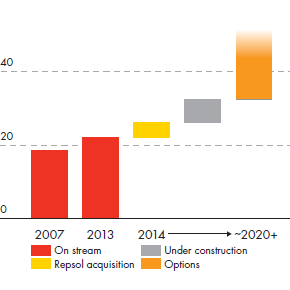LNG leadership [A] year-end mtpa

- [A]
- Projects in operation or under construction.
Shell is a pioneer of the LNG industry with expertise based on 50 years of experience. Shell was instrumental in delivery of the world’s first LNG plant, in Algeria, which came on-stream in 1964. In the years since, LNG has become a truly global commodity with demand expected to grow rapidly in the coming years. Currently around 240 mpta, the global LNG market is expected to reach about 430 mtpa by 2025. This growth will be driven by expanding economies in China, India and the Middle East, by demand in Europe and by new destinations such as Malaysia, the Philippines, Singapore, Thailand and Vietnam.
Shell is proud of its leadership in this sector. Including Qatargas 4, Pluto and the acquired Repsol LNG portfolio, Shell world-wide LNG equity liquefaction capacity is about 26 mtpa. Our equity share of various ventures across the world delivered some 9% of global LNG in 2013. The addition of volumes from our acquisition in late 2013 grows our market share to 11%.
Shell global LNG capacity growth mtpa

We currently have 7.5 mtpa capacity under construction and have around 21 mtpa of LNG options under study including Abadi in Indonesia, LNG Canada, Browse and Gorgon Train 4 in Australia.
In late 2013 Shell acquired part of Repsol S.A.’s LNG portfolio, including supply positions in Peru and Trinidad and Tobago, for a net cash purchase price of $3.8 billion, subject to post-closing adjustments. As part of the transaction, Shell also assumed $1.6 billion of balance sheet liabilities relating to existing leases for LNG ship charters. The deal gives Shell an additional 7.2 mtpa of directly managed LNG volumes of which 2.1 mtpa is uncontracted, and 5.1 mtpa is contracted to customers mainly in Canada, Mexico and Spain.
Integration of this acquisition into the Shell LNG trading portfolio is well advanced and delivering synergies and opportunities in line with expectations. Shell is uniquely placed to add value through opportunities on the gas market, by supplying contracted customers from multiple Shell LNG sources rather than a single point, and, potentially, from pipeline gas.

Pearl GTL plant laboratory.
In October 2013, the 700th LNG cargo left the Sakhalin-2 LNG plant in eastern Russia (Shell interest, 27.5%). Sakhalin-2 provides around 10% of Japan’s LNG supplies and more than 4% of South Korea’s. In the USA and Canada we have proposals to build liquefaction plants. In Western Canada, near Kitimat, British Columbia, we are progressing to a final investment decision through the LNG Canada project consortium.
In January 2014, Nigeria LNG (NLNG) exported its 3,000th LNG shipment from the Bonny Terminal in Nigeria. The first shipment left Bonny in 1999 and the plant has expanded to six trains since then. NLNG accounts for about 7% of the world’s total LNG production capacity, with the Shell Petroleum Development Company of Nigeria (SPDC) joint venture being a major supplier of gas to the plant. Shell holds a 25.6% interest in NLNG together with the Nigerian National Petroleum Corporation (49%), Total LNG Limited (15%) and ENI International N.A. (10.4%).
